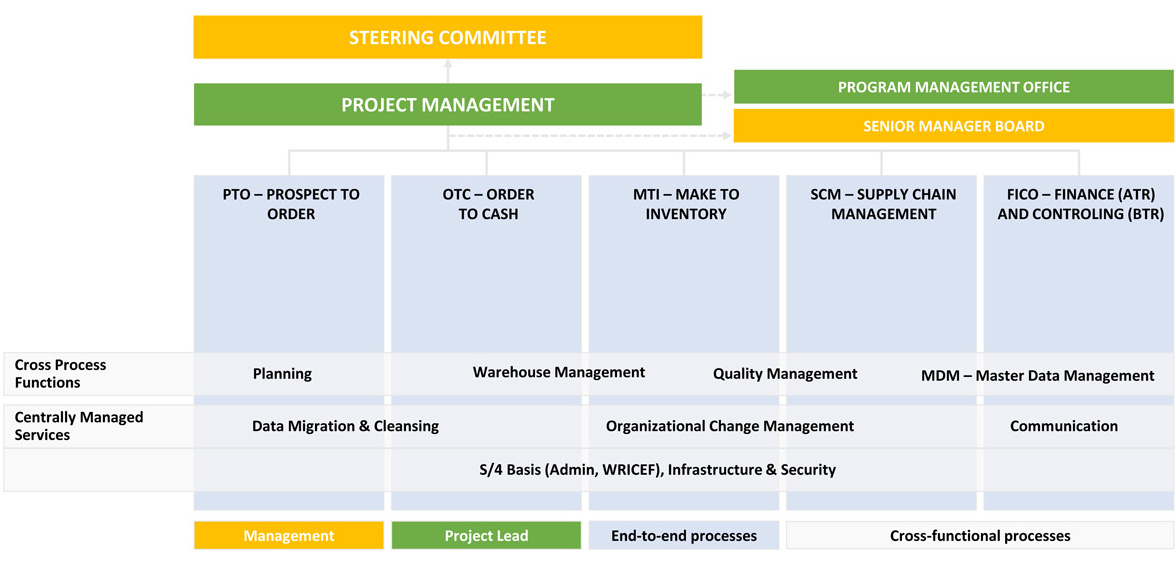Abstract: This blog post shows how to build a process-oriented project organization for SAP projects by taking integration aspects and cross-cutting tasks into account in a meaningful way, and provides recommendations for successful implementation.
In my experience, it is important to design the operational organizational structure of the project along the e2e process areas (these can be defined analogously to the e2e test areas outlined in article 10). This results in process teams with clearly defined process start events and process results (see also register “Definitions” in the Business_Process_List_SAMPLE.xlsx or page 2 in Business_Process_List_SAMPLE_EN.pdf. You can purchase and download the Excel version of the BPML via this link in Digistore24.)
Cross-cutting functions
In addition, however, there are also cross-sectional functions in the project organization that are relevant in several e2e process areas and should ideally be structured, handled and managed in the same way across all process areas. Typical examples are:
- (e)WM – storage bin administration and management: this usually plays an important role in goods receipt, in the internal supply of the production bins in the shop floor, as well as in goods issue.
- QM – Quality management: here, too, functions are usually used in goods receipt, production-accompanying in the shop floor, as well as in goods issue. In addition, this area often also has its own processes, such as handling internal quality defects, non-conformity processes or the management and calibration of test equipment.
- Integrated planning: this is perhaps the most neglected area in the introduction of SAP systems, although it is the introduction of an ERP (Enterprise Resource Planning) system, whose most inherent task is precisely the provision of these planning processes. Since this is often accompanied by a considerable organizational change and requires a high degree of integrative discipline, I strongly recommend to combine this in a separate cross-sectional team – the successful introduction of integrated planning offers by far the greatest benefit potential of an SAP implementation (An example of a detailed procedure for the entire integrated (logistical planning) in S/4HANA can be found in this example test script for planning: Test_Script sample_Planning_EN.pdf).
Affected planning process areas are:
o Program planning
o Long-term planning
o Material requirements planning
o Detailed production planning
o Demand-oriented replenishment planning
o Production preparation
o If necessary, integration of an external MES
o As well as the regular processing of negative events
- MDM – Master Data Management: Definition of the master data (models) to be used in the S/4HANA in the future and determination of the future processes for the (cross-functional) master data structure and the necessary governance to maintain the master data quality.
Centrally managed processes and functions on the project organization
In addition to these process- and function-related work areas or teams, I believe it has proven successful to define a number of work areas that are centrally managed across all processes and functions, thus ensuring that all process and function teams do not lose sight of these issues and produce similar results. They are:
- Data-Cleansing: Identification and cleansing of migration-relevant master data in the legacy systems, starting with Active-Record Identification up to the revision of content and completion of incorrectly maintained fields in the legacy system.
- OCM – Organizational Change Management: Identification of all necessary organizational changes (in the structure as well as in the process organization) for the future effective operation of S/4HANA best practice processes. Definition of all affected users; release according to the management structure; ensuring complete communication of the changes to all affected persons by the line organization by no later than before the start of the end user training. The tasks of this team then include planning, conducting and monitoring the end user training sessions and updating the personnel files of the training participants as well as ensuring that all necessary official documents (job descriptions, employment contracts, etc.) have been adapted and that all the bodies involved (e.g. employee representatives) are sufficiently and timely informed. It is clear from these tasks that this team should primarily be recruited from the HR department.
- Project communication: Especially if the introduction of the new S/4HANA system is accompanied by a series of changes, doubts, fears and even rejection quickly grow among the employees, which can lead to serious hurdles. In order to build up an increasingly higher acceptance of the future system and a positive image of it even before it goes live, it is extremely important to communicate consistently and uniformly out of the project on the different channels. It must be ensured that employees are motivated to follow the new path in order to sustain the company and their own role.
- PMO – Project Management Office: The PMO is primarily responsible for implementing and monitoring the project management processes defined by the project management and defined in the project manual. It also supports the entire team in the preparation of presentations and the planning and implementation of team events and training measures for the team. If the PMO has sufficient know-how and technical as well as temporal capacities, it is also possible to include the project communication in this.
- SAP Basis and Infrastructure: All infrastructure and SAP Basis-related topics are combined in this team. This includes in particular the future system architecture, the definition, the setup and operation of the necessary IT infrastructure, as well as the administration of the SAP Basis, the definition and implementation of authorizations and all necessary additional developments (workflows, reports, interfaces, conversions, enhancements, forms).
I call all these teams “Centrally Managed Services” and unfortunately I have to state that in many companies the understanding for the importance of all these topics, especially OCM, project communication and PMO, is not sufficiently pronounced and one is often of the opinion that one could save money in these areas – experience shows a fallacy, which in the end one often pays dearly by the fact that the new system is introduced only with many difficulties and against many resistances and this leads to an unnecessarily long and very expensive stabilization phase.
Project management and steering committee
Of course, there is also the project management, the steering committee and, depending on who is represented on the steering committee, a committee recruited from the management level of the operational managers concerned.
Schematically, the recommended project organization then looks as follows:
 Here you will find an overview of our tools, which you can purchase and download at Digistore24 and use for your project.
Here you will find an overview of our tools, which you can purchase and download at Digistore24 and use for your project.
The following article will provide an overview of the most important project management processes to be implemented.

Great article on building a project organization in a process-oriented way! The step-by-step approach and clear explanations make it easy to follow and understand. I particularly appreciate the emphasis on the importance of defining roles and responsibilities, as well as establishing communication channels to ensure the success of the project. The use of visual aids and examples further enhance the clarity of the article. Overall, a valuable resource for anyone involved in project management. Thank you for sharing!